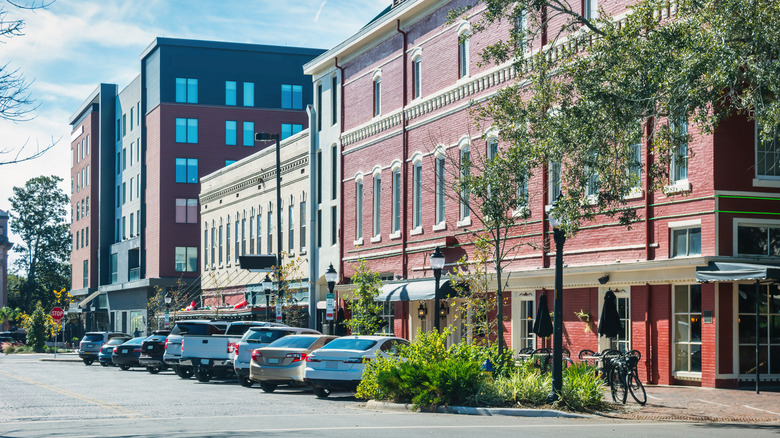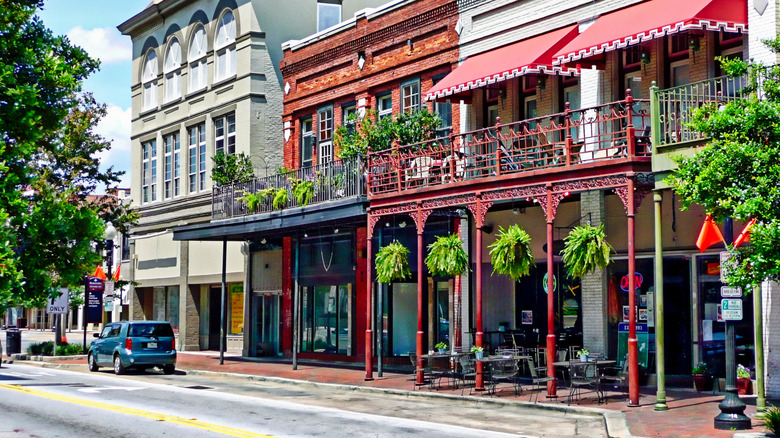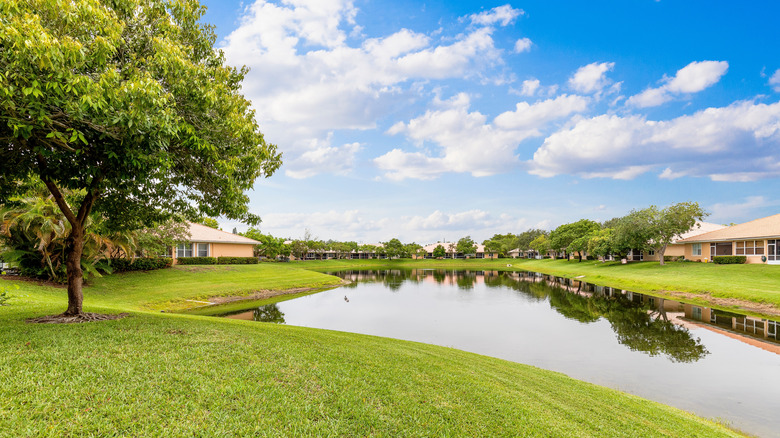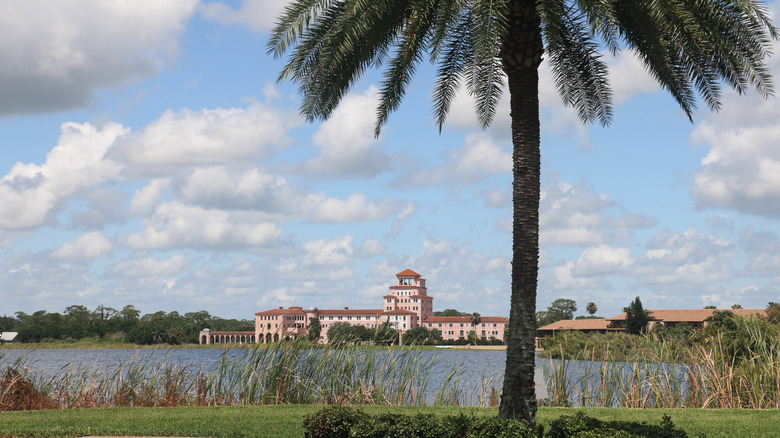The 10 Most Affordable Places To Live In Florida
The 10 most affordable places to live in Florida may be unfamiliar to you, but these are cities you'll want to keep on your radar. According to the PODS Moving Trends Report, Florida is one of several states with cities experiencing an influx of new residents. However, people don't seem to be flocking to the state in the same way as years past. While previous versions of the report included at least half a dozen Floridian locales between 2021 and 2023, just two of its cities made the list in 2025. In 2023, Florida lost its title as the preferred state for retirement.
Increasing house prices and insurance costs — the latter being one big reason retirees are moving out of Florida — have been highlighted as some of the reasons for the slowdown in new residents, where for every 1.1 new residents, one person moves out. GoBankingRates estimated that a two-person household needs to earn anywhere between $51,690 and $155,070 per year to be middle class in Florida. This demonstrates the wide range of affordability in Florida, and how much knowing where to find the most affordable places to live in the state can save you in the long run.
Panama City
While it's true there are a number of Floridian cities where buying a house will cost you, Panama City isn't necessarily one of them. According to Houseo, the median price of a home in the coastal city is around $344,400 in a city where the cost of living is 13% lower than the state average. Meanwhile, the national median price of a home, as per the Federal Reserve Bank of St. Louis, was $410,800 as of July 2025, and the median price of a home in the state was $425,000 as of October 2025. As such, the median price of a home is $66,400 lower than the national median and $80,600 lower than the state average. "Shark Tank" investor and real estate maven Barbara Corcoran may have advised against buying real estate in Florida, but home prices in Panama City offer an opportunity for new homebuyers.
Renting isn't quite as good a deal. The median rent in Panama City is $1,565 per month. The U.S. Census Bureau places the national median rent for the second quarter of 2025 at $1,494, so the cost of renting in Panama City is actually $71 higher than the national median, or $852 per year. On the bright side, the Bureau of Labor Statistics placed the average annual consumer expenditures in the U.S. at $77,280 as of 2023, while Numbeo estimates a net after-tax salary of $48,036 is needed to live in Panama City. The lower cost of living more than compensates for slightly higher rent.
Palm Bay
As one of the cheapest places to buy a house in Florida, Palm Bay offers new residents the chance to explore the great outdoors through natural amenities like proximity to national parks and hiking trails. A suburban, family-friendly environment awaits, as does a median home price of $312,450, as per HomeLight.
The median price of a home in Palm Bay is nearly $100,000 lower than both the national median and more than $100,000 less than the state median. According to Zumper, however, the median rent in Palm Bay is $1,499 for a one-bedroom unit and $1,595 for two bedrooms. That makes renting in Palm Bay slightly more expensive than the national median of $1,494 per month (via the U.S. Census Bureau).
But once again, the lower overall cost of living might make up the difference. According to BestPlaces, the cost of living in Palm Bay is 4.4% lower than the national average, as well as 7.3% lower than the state average. It also doesn't hurt that Florida is one of a few states without state income tax, allowing you to keep more of your earnings in your bank account.
Lakeland
As per BestPlaces, Lakeland has a cost of living 8.4% lower than the national average and 11.2% lower than the state average. That equates to a monthly cost of $3,333 for an individual living in the area, which is almost half the national average cost of living, $6,440 per month, as of 2023 (via the Bureau of Labor Statistics).
Located just southeast of Orlando, Lakeland is a city where the cost of utilities won't have you seeking out tips to save money on your electricity bill, as Uphomes estimates that it is 2% below the U.S. average. It's not much, but a win is a win. The lower cost associated with housing — represented by a $310,000 median home price, as per Houzeo – is also certainly nothing to sneeze at. The median rent in Lakeland is $1,525, which may be higher than the U.S. Census Bureau national median calculation of $1,494, but is softened by that lower cost of living.
Gainesville
There's a large community of young professionals in Gainesville, which is home to the University of Florida. However, the college town is also recognized as one of the best places for retirement. According to reAlpha, the median price of a home in Gainesville is somewhere between $280,000 and $300,000. Next to the Federal Reserve Bank of St. Louis data supporting a national average of $410,800, the cost of owning a home is much more favorable in Gainesville.
An average mortgage payment of $1,850 per month comes at a serious discount to the U.S. average — which, as per a September 2025 Rocket Mortgage estimate, sits at $2,329 per month. Combined with taxes and insurance, that amounts to a total cost of home ownership of $2,260 per month and a cost of living that's 5% lower than the national average. As per ZillowRentals, the average monthly rent in Gainesville is $1,600, so you can also save yourself an average of $400 per month against the national average of $2,000. That translates to $4,800 in annual savings.
Pensacola
According to the Council for Community and Economic Research (C2ER) via RentCafe, Pensacola's cost of living is 14% lower than the state average and 13% lower than the national average. That's thanks to housing that is 25% lower, food and out-of-pocket healthcare expenses that are 14% lower, and goods and services that are 12% lower than the national average. With healthcare less costly and the cost of living being retirement budget-friendly, Pensacola is undoubtedly one of the best coastal towns in Florida for retirees.
The median price of a home in Pensacola hovers between $260,000 and $280,000, as per reAlpha. According to United Van Lines, the median gross rent is an impressive $1,209 per month. With the median home price, rent, and the general cost of living falling significantly below the national average, you could do much worse in terms of affordability than in Pensacola. The average mortgage payment in Pensacola is $1,700 per month, compared to the Rocket Mortgage national average of $2,329. That's $629 per month, or $7,548 per year, cheaper than the national average.
Pine Hills
Pine Hills is located within the Orlando metropolitan area. According to an October 2025 estimate by RentCafe, monthly rent in Pine Hills costs an average of $1,322. The discount is huge compared to the national average of $2,000. The $678 per month adds up to a significant $8,136 per year, and is representative of an appealing cost of living that can help you avoid the pitfalls of lifestyle inflation.
While homeownership often feels like a pipedream today, this is not the case in Pine Hills, where the median home price is $256,500 (via Redfin). Putting that against the Federal Reserve Bank of St. Louis' U.S. average calculation of $410,800, and the state average the Federal Reserve Bank of St. Louis places at $425,000, Pine Hills is an affordable option, any way you look at it.
Rocket Mortgage puts the national average mortgage at $2,329 per month with a 6.68% interest rate, without a specific down payment amount. Using the same calculations related to the median price of a home in Pine Hills, your estimated monthly mortgage payment would be $1,652 per month. It's no wonder, then, that as per the Economic Research Institute, the cost of living in Pine Hills is 9% lower than the national average and 16% lower than the state average based on costs such as food, transportation, healthcare, rent, utilities, and taxes.
Inverness
As per reAlpha, the median price of a home in Inverness is $200,000 to $220,000. This helps lower the average mortgage payment to $1,350 per month. With the average mortgage payment in the U.S. climbing to $2,329 per month, as per Rocket Mortgage, you are already winning where affordability is concerned. Even with a total monthly average housing cost of $1,670 per month when you include property taxes and insurance, you're still well below the national average.
While there are reasons retirees have come to regret moving to Florida, that doesn't seem to be the case in Inverness. Home appreciation is projected to rise by 15% to 18% in the coming years, thanks to an influx of retirees. It helps that, as per Livability, the median rent in Inverness is a comfortable $821 per month, handily beating the second-quarter national average, as per the U.S. Census Bureau, of $1,494 per month.
According to BestPlaces, one would need a monthly income of $2,367 to live comfortably in Inverness, versus what the Bureau of Labor Statistics estimates is $6,440 per month nationwide. Altogether, the Economic Research Institute estimates that the cost of living is 8% lower than the national average and 16% lower than the Sunshine State's average.
Sebring
According to reAlpha, Sebring's median home price sits anywhere between $190,000 and $210,000. Its average mortgage payment comes to an expense of $1,300, again making the Rocket Mortgage median monthly mortgage estimate of $2,329 look downright exorbitant. As per the BestPlaces, a single person would need $2,300 per month to live comfortably in the Central Florida city, where the cost of living is 17% lower than the national average and 19.5% lower than the state average.
With an annual income of $27,600 needed to live decently in Sebring, compared to the Bureau of Labor Statistics national estimate of $77,280 per year, it becomes apparent just how much more affordable it is than many other parts of the country and state. This is helped by the low average monthly rent. According to RentCafe, this sits at around $883 for a one-bedroom, or $1,120 on average for all units, which is notably lower than national statistics.
College Gardens
Located in Jacksonville, College Gardens can offer affordable housing. In fact, according to NeighborhoodScout, the median price of a home in College Gardens is $116,404, making it more affordable than 93.4% of homes in the U.S. and 96.5% less than homes in the state. That said, the neighborhood is not without problems, including socioeconomic challenges that lead to residents in College Gardens having incomes lower than 97.6% of neighborhoods in the U.S. The childhood poverty rate in College Gardens is also 83.4% higher than the national average.
While this Jacksonville neighborhood is certainly affordable, the crime rate, as per FBI data via AreaVibes, is a full 50% above the national average. That said, AreaVibes does lists several areas in and around College Gardens that have A grades for safety, so it can be important to choose the right neighborhood. According to Point2Homes, the median gross rent in College Gardens is $1,042 per month, making the area an affordable option for renters. While affordability may be top of mind, College Gardens may not be your best bet thanks to the impact of climate change on home insurance in certain cities. According to Jacksonville Today the rising threat of natural disasters like flooding and hurricanes may eventually make areas like College Gardens unsustainable.
Chattahoochee
The interestingly named Chattahoochee is somewhere so affordable that a retiree could live there on Social Security alone. Comparing the median home value in Chattahoochee — just $82,900, according to Niche — with the national median estimated by the Federal Reserve Bank of St. Louis of $410,800, reveals homeownership comes at close to a fifth of the cost of your average home in the U.S. Renting in Chattahoochee follows a similar pattern. Located within the Tallahassee metropolitan area, Chattahoochee offers a median rent of $571. This falls well below the second-quarter national median of $1,494 (via the U.S. Census Bureau).
According to BestPlaces, this amounts to a cost of living where an individual earning $2,933 per month, or $35,200 a year, could live comfortably while covering the cost of groceries, healthcare, childcare, housing, transportation, and miscellaneous goods and services. That's especially impressive when you consider that the Bureau of Labor Statistics estimates the national annual consumer expenditure to be $77,280. Chattahoochee's affordability would make it much easier to live on retirement savings of $250,000 than in other areas of Florida.










